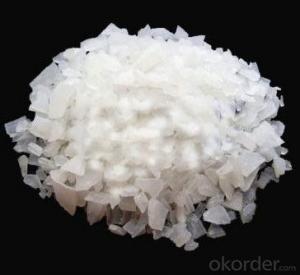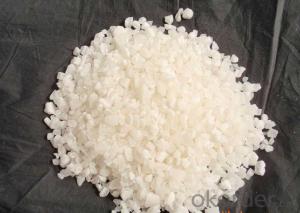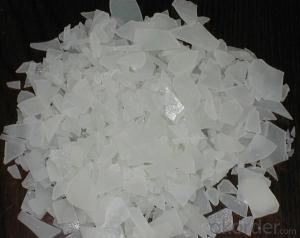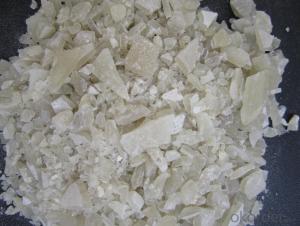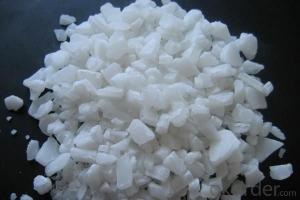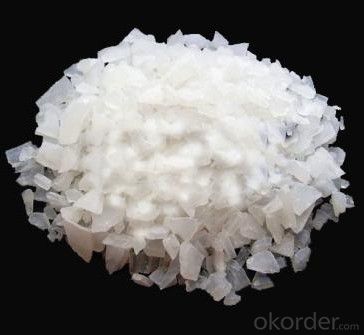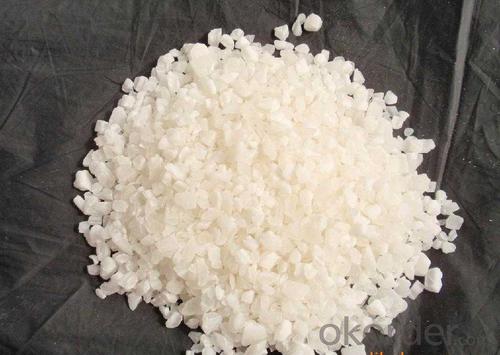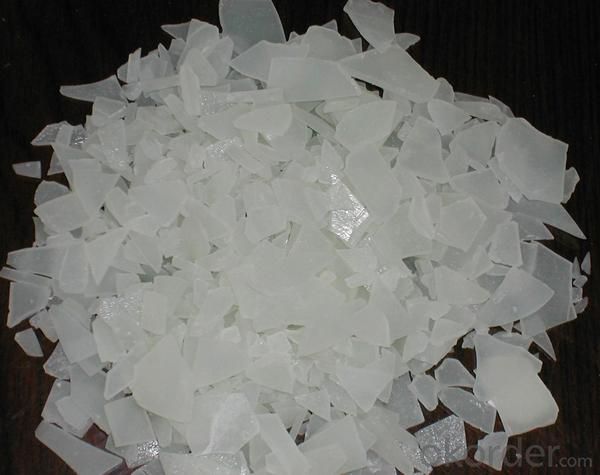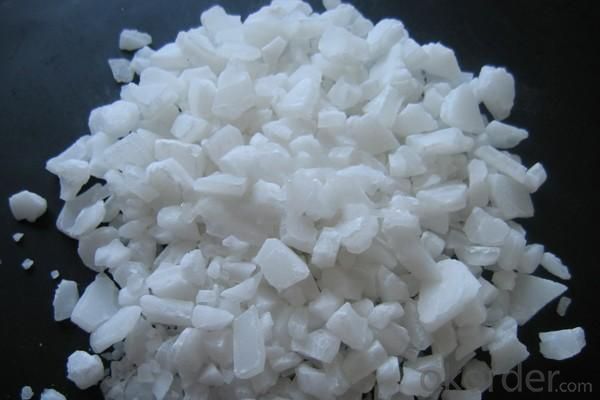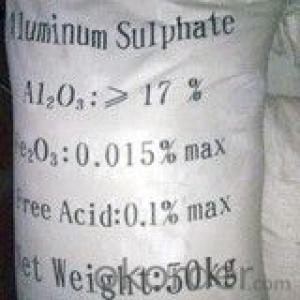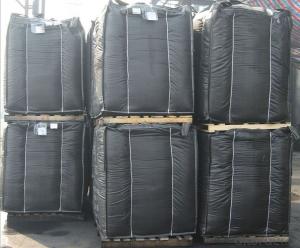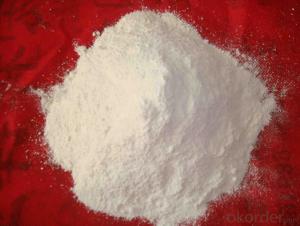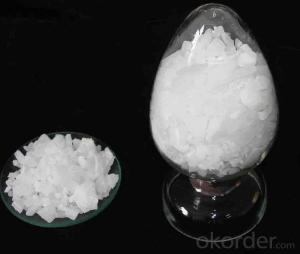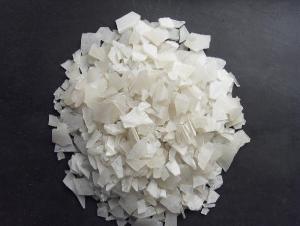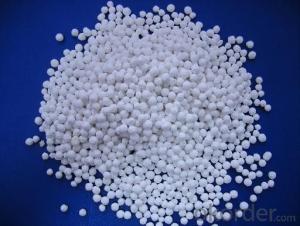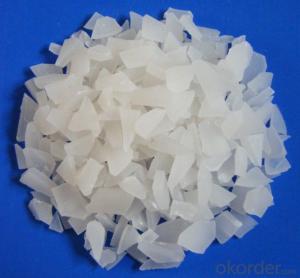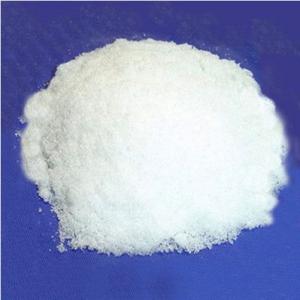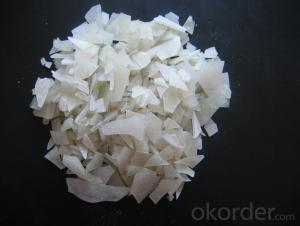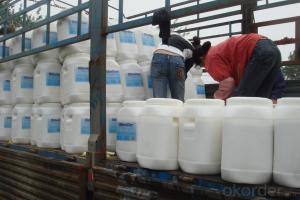Aluminum Sulfate Industrial Grade Used For Water Treatment
- Loading Port:
- Qingdao
- Payment Terms:
- TT OR LC
- Min Order Qty:
- 25 m.t.
- Supply Capability:
- 12000 m.t./month
OKorder Service Pledge
OKorder Financial Service
You Might Also Like
1. Chemical and Physical Properties:
Product name: Aluminium Sulphate or Aluminum Sulfate
Shape: Flakes or Granular or Powder.
EINECS NO.:233-135-0
CAS No.: 10043-01-3
HS.Code: 28332200
Molecular Formula: Al2(SO4)3
Appearance:It is white or grey flake,particle or massive crystallization.
Apt to cake after moisture absorption when laid in air for a long time.A little green because of Fe2+ ,yellow when Fe2+ is oxided to Fe3+.Soluble in water easily,and water solution is acid.
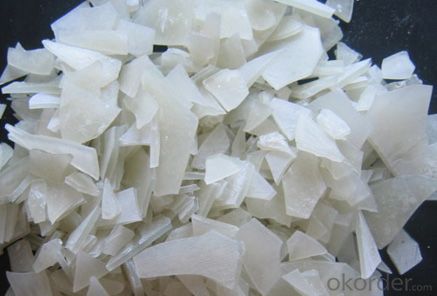
2. Specification:
Standard: HG/T 2225-2001 and HG/T 2227-2004
Items | Specifications | |||
I Type:Low Ferrous/Low Iron | II Type:Non-Ferrous/Iron-free | |||
First Class | Qualified | First Class | Qualified | |
Al2O3 % ≥ | 15.8 | 15.6 | 17 | 16 |
Ferrous(Fe )% ≤ | 0.5 | 0.7 | 0.005 | 0.01 |
Water Insolube % ≤ | 0.1 | 0.15 | 0.1 | 0.15 |
PH (1% aqueous solution) ≥ | 3.0 | 3.0 | 3.0 | 3.0 |
Arsenic(As) %≤ | 0.0005 | 0.0005 | ||
Heavy metal (Pb) %≤ | 0.002 | 0.002 | ||
3.Applications:
Water effluent treatment system
It's used for purification of drinking water and wastewater treatment by settling of impurities by
means of precipitation and flocculation.
Paper Industry
It helps in sizing of paper at neutral and alkaline pH, thus improving paper quality (reducing spots
and holes and improving sheet formation and strength) and sizing efficiency.
Textile Industry
It is used for color fixing in Naphthol based dyes for cotton fabric.
Other Uses
Leather tanning, lubricating compositions, fire retardants; decolorizing agent in petroleum, deodorizer; food additive; firming agent; dyeing mordant; foaming agent in firefighting foams; fireproofing cloth; catalyst; pH control; waterproofing concrete; aluminum compounds, zeolites etc.
4. Package:
Packaging Detail: PP/PE 50kg/bag;25kg/bag;Jumbo bag or according to customers' requirements.
20-25MT will be loaded in per 20'FCL container.
5. Attention and Storage:
The product is liable to absorb moisture and clot due to long-term exposure, so shady, cool and ventilated environment is needed.
Ammonium Aluminum Sulfate, Aluminum Ammonium Sulfate, Ammonium Alum, Alum
Molecular formula: AINH4(SO4)2·12H2O
CAS NO.: 7784-25-0
Character: white crytal
Useage: used in food, preserves, water purity, disinfection, rubber, leather, washing powder, livestock feed, pencils etc
Specification:
Purity -- 99.3%~100.5%
Moisture -- 4% max
Water Insoluble Matter -- 0.2% max
As -- 0.0002 max
Package: 25kg plastic woven bag
Capacity of loading: 25MT/1X20' FCL(non-palletized)
- Q: High school chemistry, catalyst activation energy map
- Catalytic reaction is the reaction of the first reaction with the catalyst or attached to the catalyst to form intermediates, and then further reaction to produce products and catalysts, so the amount of catalyst in theory is the same! The activation of these two processes can be reduced! So there will be two peaks! Can be simplified as a peak!
- Q: The concept of catalyst in high school chemistry
- The catalyst is selective, that is, a catalyst that catalyzes only one or more chemical reactions and does not catalyze all chemical reactions. However, a chemical reaction of the catalyst may be a variety of, such as hydrogen peroxide to produce oxygen in the reaction, in addition to the use of manganese dioxide as a catalyst, you can also use copper oxide, iron oxide as a catalyst. Building on the use of cement, red brick powder also catalyze the decomposition of hydrogen peroxide.
- Q: Could you please explain it, i know they increase reaction rates but how?
- A catalyst lowers the activation energy (the minimum amount of energy needed for a reaction to take place). This means that the particles can react with less energy than they needed before the catalyst was added. (Think about it: if the government lowered the legal age to buy cigarettes, then more people could legally buy cigarettes. Similarly, if we lower the amount of energy needed for particles to react, then more particles can react). Also, a catalyst provides a surface on which the reaction can take place. This increases the number of collisions between the particles of the substances that are reacting.
- Q: What is the nature of the chemical catalyst?
- Can only speed up or slow down the reaction rate, can not change the reaction balance,
- Q: What is the difference between biological enzymes and chemical catalysts?
- Biological enzymes are an environmentally friendly biocatalyst with greater superiority. Such as the reaction speed, processing conditions (such as temperature, PH value, etc.) more moderate, safe and easy to control the operation and can replace the strong alkali and other chemicals. The biological enzymes act only on specific substrates, with little damage to the substrate and the biodegradation of the treated wastewater to reduce water and energy consumption. After more than a century of research by scientists, more than 3,000 known enzymes are generally considered. The application of biological enzymes in the textile industry, initially the application of α-amylase in cotton fabric desizing process, and later developed into the cellulase used in denim washing and bio-polishing process, and now the development of pectinase to the biological scouring Technology, hydrogen peroxide enzyme catalytic decomposition technology, protease in silk and wool fiber applications
- Q: Chemical catalyst in several ways
- Two, can speed up and slow down
- Q: Please name 2 common examples of catalysts.Thank you?
- Easter in making Curd fermentation.Sodium bi carbonate in faster flour formation. these are used in the domestic kitchen mostly.
- Q: What is the meaning of catalyst in chemistry?
- In the chemical reaction can change the reaction rate of chemical reaction (increase or decrease) without changing the chemical balance, and its own quality and chemical properties in the chemical reaction before and after the material did not change the catalyst.
- Q: What are the catalysts?
- The relationship between it and the reaction system is as highly selective (or specific) as the relationship with the key. A catalyst does not catalyze all chemical reactions, such as manganese dioxide in the decomposition of potassium chlorate Play a catalytic role to speed up the chemical reaction rate, but the other chemical reactions do not necessarily have a catalytic effect
- Q: Does all chemical reactions have a catalyst?
- Not some reaction without catalyst
Send your message to us
Aluminum Sulfate Industrial Grade Used For Water Treatment
- Loading Port:
- Qingdao
- Payment Terms:
- TT OR LC
- Min Order Qty:
- 25 m.t.
- Supply Capability:
- 12000 m.t./month
OKorder Service Pledge
OKorder Financial Service
Similar products
Hot products
Hot Searches
Related keywords
